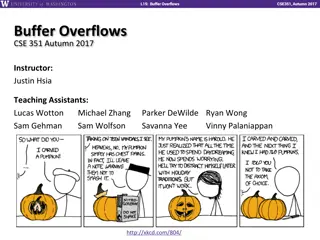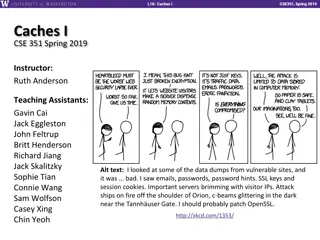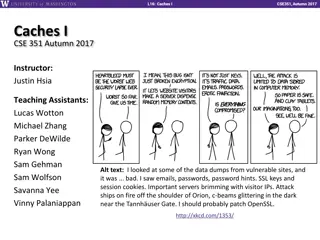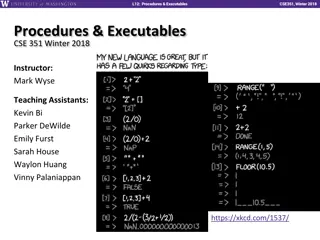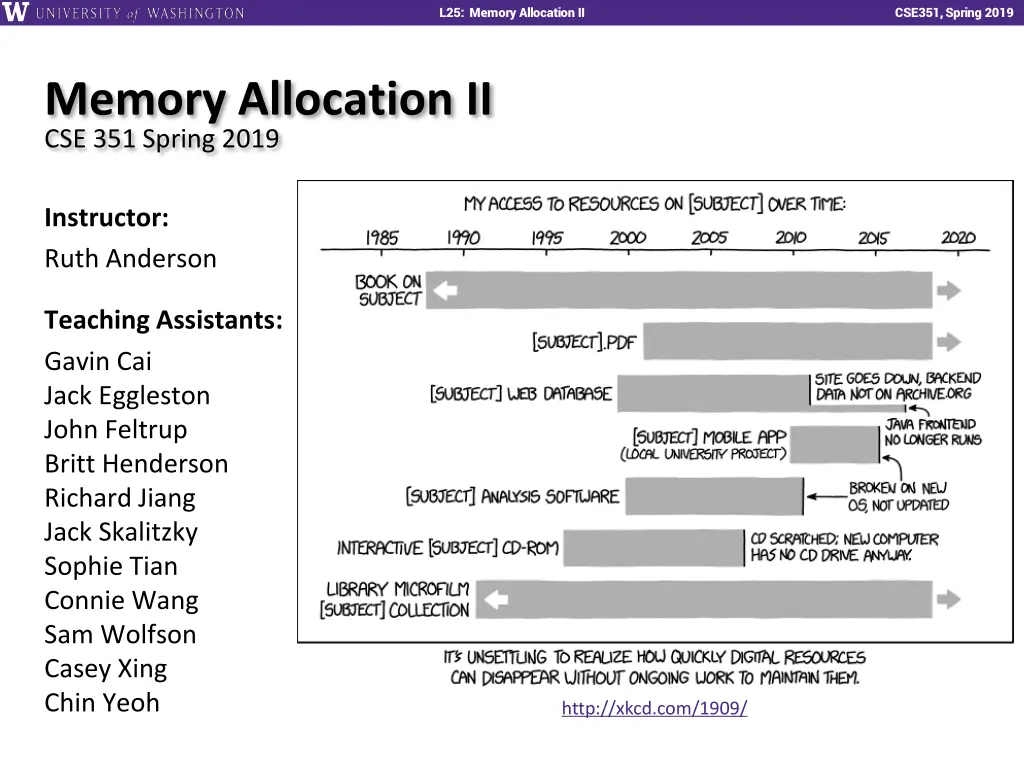
Advanced Memory Allocation Techniques in CSE351 Spring 2019
Explore advanced memory allocation concepts from the CSE351 course in Spring 2019, covering topics such as heap management, allocation strategies, implicit list allocation, and techniques to reduce fragmentation. Dive into practical examples and peer instruction questions to enhance your understanding.
Download Presentation

Please find below an Image/Link to download the presentation.
The content on the website is provided AS IS for your information and personal use only. It may not be sold, licensed, or shared on other websites without obtaining consent from the author. If you encounter any issues during the download, it is possible that the publisher has removed the file from their server.
You are allowed to download the files provided on this website for personal or commercial use, subject to the condition that they are used lawfully. All files are the property of their respective owners.
The content on the website is provided AS IS for your information and personal use only. It may not be sold, licensed, or shared on other websites without obtaining consent from the author.
E N D
Presentation Transcript
L25: Memory Allocation II CSE351, Spring 2019 Memory Allocation II CSE 351 Spring 2019 Instructor: Ruth Anderson Teaching Assistants: Gavin Cai Jack Eggleston John Feltrup Britt Henderson Richard Jiang Jack Skalitzky Sophie Tian Connie Wang Sam Wolfson Casey Xing Chin Yeoh http://xkcd.com/1909/
L25: Memory Allocation II CSE351, Spring 2019 Administrivia Homework 5, due Friday (5/31) Processes and Virtual Memory Lab 5, released Wed Evening, due Friday (6/7) Memory Allocation Recommended that you watch the Lab 5 helper videos Sunday 6/9 is last day Lab 5 may be submitted (if one late day is used) Final Exam: Wed, 6/12, 12:30-2:20 pm in KNE 130 2
L25: Memory Allocation II CSE351, Spring 2019 Peer Instruction Question payload size Which allocation strategy and requests remove external fragmentation in this Heap? B3 was the last fulfilled request. http://pollev.com/rea Best-fit: malloc(50), malloc(50) First-fit: malloc(50), malloc(30) Next-fit: malloc(30), malloc(50) Next-fit: malloc(50), malloc(30) 50 B2 10 (A) 30 B3 10 (B) 50 (C) B1 50 (D) Start of heap 3
L25: Memory Allocation II CSE351, Spring 2019 Implicit List: Allocating in a Free Block Allocating in a free block: splitting Since allocated space might be smaller than free space, we might want to split the block Assume ptr points to a free block and has unscaled pointer arithmetic void split(ptr b, int bytes) { // bytes = desired block size int newsize = ((bytes+15) >> 4) << 4; // round up to multiple of 16 int oldsize = *b; // why not mask out low bit? *b = newsize; // initially unallocated if (newsize < oldsize) *(b+newsize) = oldsize - newsize; } // part of block (UNSCALED +) // set length in remaining 48|0 16|1 16|1 malloc(24): ptr b = find(24+8) split(b, 24+8) allocate(b) Free word b Allocated word Newly-allocated word 16|0 32|1 16|1 16|1 4
L25: Memory Allocation II CSE351, Spring 2019 Implicit List: Freeing a Block Simplest implementation just clears allocated flag void free(ptr p) {*(p-WORD) &= -2;} But can lead to false fragmentation 16|0 32|1 16|1 16|1 Free word p Allocated word Block of interest free(p) 16|0 32|0 16|1 16|1 malloc(40) Oops! There is enough free space, but the allocator won t be able to find it 5
L25: Memory Allocation II CSE351, Spring 2019 Implicit List: Coalescing with Next Join (coalesce) with next block if also free 16|0 32|1 16|1 16|1 Free word p Allocated word Block of interest free(p) 16|0 48|0 16|1 16|1 logically gone void free(ptr p) { // p points to payload ptr b = p WORD; // b points to block header *b &= -2; // clear allocated bit ptr next = b + *b; // find next block (UNSCALED +) if ((*next & 1) == 0) // if next block is not allocated, *b += *next; // add its size to this block } How do we coalesce with the previous block? 6
L25: Memory Allocation II CSE351, Spring 2019 Implicit List: Bidirectional Coalescing Boundary tags[Knuth73] Replicate header at bottom (end) of free blocks Allows us to traverse backwards, but requires extra space Important and general technique! 32/0 32/032/1 32/1 48/0 48/032/1 32/1 Format of allocated and free blocks: a = 1: allocated block a = 0: free block Header size a payload and padding size: block size (in bytes) Boundary tags payload: application data (allocated blocks only) Footer size a 7
L25: Memory Allocation II CSE351, Spring 2019 Constant Time Coalescing Case 1 Case 2 Case 3 Case 4 Allocated Allocated Free Free Block being freed Allocated Free Allocated Free 8
L25: Memory Allocation II CSE351, Spring 2019 Constant Time Coalescing m1 1 m1 1 m1 1 m1 1 Case 1 Case 2 m1 n 1 1 m1 n 1 0 m1 n 1 1 m1 n+m2 1 0 n 1 1 n 0 1 n 1 0 m2 m2 m2 m2 1 m2 1 m2 0 n+m2 0 m1 0 n+m1 0 m1 0 n+m1+m2 0 Case 3 Case 4 m1 n 0 1 m1 n 0 1 n 1 1 n+m1 m2 0 1 n 1 0 m2 m2 m2 1 m2 1 m2 0 n+m1+m2 0
L25: Memory Allocation II CSE351, Spring 2019 Implicit Free List Review Questions 32/0 32/032/1 32/1 48/0 48/032/1 32/1 What is the block header? What do we store and how? What are boundary tags and why do we need them? When we coalesce free blocks, how many neighboring blocks do we need to check on either side? Why is this? If I want to check the size of the ?-th block forward from the current block, how many memory accesses do I make? 10
L25: Memory Allocation II CSE351, Spring 2019 = 8-byte box (free) Keeping Track of Free Blocks = 8-byte box (allocated) 1) Implicit free list using length links all blocks using math No actual pointers, and must check each block if allocated or free 40 32 48 16 2) Explicit free list among only the free blocks, using pointers 40 32 48 16 3) Segregated free list Different free lists for different size classes 4) Blocks sorted by size Can use a balanced binary tree (e.g. red-black tree) with pointers within each free block, and the length used as a key 11
L25: Memory Allocation II CSE351, Spring 2019 Explicit Free Lists Allocated block: Free block: size a size a next prev payload and padding size a size a (same as implicit free list) Use list(s) of free blocks, rather than implicit list of all blocks The next free block could be anywhere in the heap So we need to store next/previous pointers, not just sizes Since we only track free blocks, so we can use payload for pointers Still need boundary tags (header/footer) for coalescing 12
L25: Memory Allocation II CSE351, Spring 2019 Doubly-Linked Lists Linear Needs head/root pointer First node prev pointer is NULL Last node next pointer is NULL Good for first-fit, best-fit Root Start Circular Still have pointer to tell you which node to start with No NULL pointers (term condition is back at starting point) Good for next-fit, best-fit 13
L25: Memory Allocation II CSE351, Spring 2019 Explicit Free Lists Logically: doubly-linked list A B C Physically: blocks can be in any order Forward (next) links A B 32 32 32 32 48 48 32 32 32 32 C Back (prev) links 14
L25: Memory Allocation II CSE351, Spring 2019 Allocating From Explicit Free Lists Note: These diagrams are not very specific about whereinside a block a pointer points. In reality we would always point to one place (e.g. start/header of a block). Before After (with splitting) = malloc( ) 15
L25: Memory Allocation II CSE351, Spring 2019 Allocating From Explicit Free Lists Note: These diagrams are not very specific about whereinside a block a pointer points. In reality we would always point to one place (e.g. start/header of a block). Before After (fully allocated) = malloc( ) 16
L25: Memory Allocation II CSE351, Spring 2019 Freeing With Explicit Free Lists Insertion policy: Where in the free list do you put the newly freed block? LIFO (last-in-first-out) policy Insert freed block at the beginning (head) of the free list Pro: simple and constant time Con: studies suggest fragmentation is worse than the alternative Address-ordered policy Insert freed blocks so that free list blocks are always in address order: address(previous) < address(current) < address(next) Con: requires linear-time search Pro: studies suggest fragmentation is better than the alternative 17
L25: Memory Allocation II CSE351, Spring 2019 Coalescing in Explicit Free Lists Case 1 Case 2 Case 3 Case 4 Allocated Allocated Free Free Block being freed Allocated Free Allocated Free Neighboring free blocks are already part of the free list 1) Remove old block from free list 2) Create new, larger coalesced block 3) Add new block to free list (insertion policy) How do we tell if a neighboring block if free? 18
L25: Memory Allocation II CSE351, Spring 2019 Boundary tags not shown, but don t forget about them! Freeing with LIFO Policy (Case 1) Before free( ) Root Insert the freed block at the root of the list After Root 19
L25: Memory Allocation II CSE351, Spring 2019 Boundary tags not shown, but don t forget about them! Freeing with LIFO Policy (Case 2) Before free( ) Root Splice successor block out of list, coalesce both memory blocks, and insert the new block at the root of the list After Root 20
L25: Memory Allocation II CSE351, Spring 2019 Boundary tags not shown, but don t forget about them! Freeing with LIFO Policy (Case 3) Before free( ) Root Splice predecessor block out of list, coalesce both memory blocks, and insert the new block at the root of the list After Root 21
L25: Memory Allocation II CSE351, Spring 2019 Boundary tags not shown, but don t forget about them! Freeing with LIFO Policy (Case 4) Before free( ) Root Splice predecessor and successor blocks out of list, coalesce all 3 memory blocks, and insert the new block at the root of the list After Root 22
L25: Memory Allocation II CSE351, Spring 2019 Do we always need the boundary tags? Allocated block: Free block: size a size a next prev payload and padding size a size a (same as implicit free list) Lab 5 suggests no 23
L25: Memory Allocation II CSE351, Spring 2019 Explicit List Summary Comparison with implicit list: Block allocation is linear time in number of free blocks instead of all blocks Much faster when most of the memory is full Slightly more complicated allocate and free since we need to splice blocks in and out of the list Some extra space for the links (2 extra pointers needed for each free block) Increases minimum block size, leading to more internal fragmentation Most common use of explicit lists is in conjunction with segregated free lists Keep multiple linked lists of different size classes, or possibly for different types of objects 24
L25: Memory Allocation II CSE351, Spring 2019 BONUS SLIDES The following slides are about the SegList Allocator, for those curious. You will NOT be expected to know this material. 25
L25: Memory Allocation II CSE351, Spring 2019 SegList Allocator Have an array of free lists for various size classes To allocate a block of size ?: Search appropriate free list for block of size ? ? If an appropriate block is found: [Optional] Split block and place free fragment on appropriate list If no block is found, try the next larger class Repeat until block is found If no block is found: Request additional heap memory from OS (using sbrk) Place remainder of additional heap memory as a single free block in appropriate size class 26
L25: Memory Allocation II CSE351, Spring 2019 SegList Allocator Have an array of free lists for various size classes To free a block: Mark block as free Coalesce (if needed) Place on appropriate class list 27
L25: Memory Allocation II CSE351, Spring 2019 SegList Advantages Higher throughput Search is log time for power-of-two size classes Better memory utilization First-fit search of seglist approximates a best-fit search of entire heap Extreme case: Giving every block its own size class is no worse than best-fit search of an explicit list Don t need to use space for block size for the fixed-size classes 28

